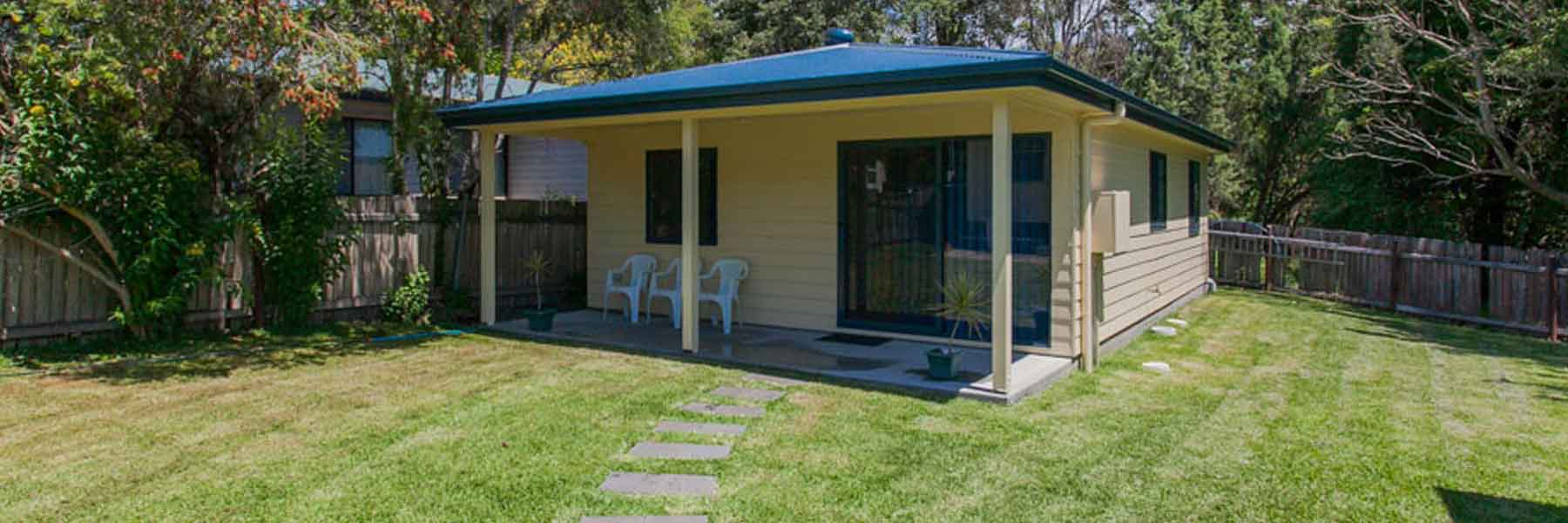Home > Home Loans > Owner-Builder Loans
Owner-Builder Loans
Find out how owner-builder loans work when you want to buy land and construct your own home here.
Author
Savvy Editorial TeamFact checked
If you’re looking to construct your home from the ground up, you’ll probably need an owner-builder home loan to turn your dream into bricks and mortar. Owner-builder loans help keep loan repayments low during the building phase of a new home. Read on to find out more about construction loans and how they can be used to ease the financial stress of building.
You can compare different home loans with Savvy and have all the information you need to get the best loan interest rate and loan terms possible.
How does an owner-builder loan work?
This type of loan (otherwise known as a construction loan) is specifically designed for people who want to build their own home or renovate an existing dwelling. Instead of receiving your loan all at once, the lender releases the loan money in stages and pays your builder directly with progress payments. During construction, you pay interest-only instalments just on the actual dollar amount which has been released.
Once construction is complete, the loan usually reverts to a more standard principal and interest (P&I) loan, or you refinance to a standard owner-occupier loan. The amount you’re able to spend to build your home will depend on the loan amount your lender has pre-approved for you, which will be determined by how much deposit you’re able to offer and what repayments you can afford. Typically, lenders require a larger deposit and offer higher loan interest rates for owner-builder home loans.
Most construction lenders will offer a loan equivalent to 65% to 70% of the build value of your new home for first-time builders. The build value is an estimate of what the house will be worth once it’s complete. Experienced professional builders can be approved for up to 80% to 95% of the build value.
What are the stages of an owner-builder construction loan?
The average build usually has around five to seven stages and sually given between 12 and 24 months to complete the building of your house starting from the signature date on your building contract. Each construction stage is assessed by the lender before they release funds for the next stage to proceed. The release of money on your behalf is known as a draw-down on your loan. These are the typical common stages of a property build and the approximate percentage of your loan amount released at each stage:
- Deposit and block clearance: 10%
- Foundation or slab pour: 10%
- Framing or brickwork: 20%
- Lockup: 20%
- Second fix: 30%
- Completion and handover: 10%
How much does an owner-builder loan cost compared to other home loans?
Expect much higher administration fees with construction loans compared to standard home loans. Some lenders charge a one-off administration fee at the start of the owner-builder loan approval process (often around $600-$800), while other lenders charge a fee at each stage as they release funds (often around $75 per stage.) These fees can add up and need to be taken into account when comparing owner-builder mortgages. In comparison, many online lenders are now offering standard P&I loans with no setup or administration fees at all, although these can come in at around $150 to $700 and $5 to $20 per month, respectively.
Additionally, since owner-builder mortgages are secured by an asset that hasn’t yet been constructed, lenders are taking on more risk than with a standard mortgage, and so they’ll likely charge you a higher interest rate. Standard P&I loans for a borrower with over 20% deposit can often attract lower interest rates, whilst owner-building loan interest rates will typically be 0.5 to 1 percentage point higher. Savvy can help you compare mortgages side-by-side so you can see which offer is right for you.
What documents will I need for an owner-builder loan?
Getting approval for an owner-builder construction loan is more difficult than getting a standard home loan, and frequently involves plenty of paperwork. This is because, in addition to assessing your suitability as a borrower, the lender also has to look at the risks involved with the dwelling you’re proposing to build. To be successful, you’ll need to have a good credit history. Lenders will require all the standard home loan documentation, including:
- proof of ID – 100 points
- your income details
- a list of your existing assets and liabilities
- details of your monthly bills and commitments
In addition, you’ll likely need to supply the following:
- Council building permits and plans
- Professional building plans
- Proof of land purchase
- Your contract with the builder
- Progressive payment schedule
- Proof of insurance
- A contingency plan in case things go wrong (for example, proof that additional insurance has been taken out to fully protect the owner-builder)
What insurance will I need before I get approved for an owner-builder home loan?
All lenders will require you to have adequate insurance to cover you as an owner-builder in case anything goes wrong during the construction period. The exact insurance you’ll be required to take out varies from lender to lender, but the most common types of insurance are:
- Construction Works insurance. Also known as Contract Works Insurance, this covers any damage to the site or property that occurs during the build, including theft of materials and vandalism. It also protects you in case a natural disaster such as a bushfire or cyclone destroys your partially-built home.
- Domestic/home warranty insurance. This insurance will protect you if your builder doesn’t complete the project on time, is late to complete a stage deadline, or goes bankrupt during construction. It also covers you for serious structural defects and for legal costs which may be incurred if a court case results.
- Public Liability insurance. As you’re responsible for everything that happens on your building site, public liability insurance will protect you if workers are injured during construction, or if your neighbour’s property is damaged during the building process.
- Personal accident/injury insurance. This should cover you and your family in case you’re injured whilst visiting or inspecting your house as it’s being built. Some personal accident insurance contracts specify that anyone on the building site must wear personal protection equipment, so check what the requirements are in your policy.
Your home loan options
Making your first big step towards buying a home? It's crucial to be across your mortgage options as a first homebuyer.
Opting for a variable interest rate on your home loan means it'll fluctuate as the market moves throughout your repayment term.
On the other hand, fixing your rate locks it in for a pre-defined period. This can bring with it greater certainty around your budget.
It's important not to set and forget when it comes to your home loan. If you find a more competitive offer, it may be worth refinancing.
If you're looking to build a new house, construction loans are specifically designed to cater to the different needs associated with doing so.
A guarantor essentially acts as a safety net for your lender, as they sign onto your loan to agree to pay it off should you become unable to do so.
Purchasing a property as an investment brings with it different specifications from a lender. It's crucial to know what your options are.
Businesses big or small may wish to purchase a property for commercial purposes, which are also different from a standard loan.
Your home loan may give you an interest-only option, which allows you to exclusively pay interest on your loan for a set period.
Just because your finances may be slightly more complicated as a self-employed individual doesn't mean you can't take out a home loan.
Some lenders may allow you to apply for a home loan with alternative documents, such as tax returns, BAS and ABN registration.
There are several options for purchasing a property without a cash deposit, such as equity in another property if you or your guarantor own one.
Why compare home loans with Savvy?
100% free
You don't have to pay a cent to compare home loans with us, enabling you to do so at any time.
Paperless quote process
You can fill out a simple online quote via our form without having to worry about sorting through heaps of paperwork.
Trusted lenders
With a panel of reputable mortgage lenders behind us, you can rest assured you'll be comparing high-quality options.
How does the application process for an owner-builder construction loan work?
Decide what size and type of home you want to build
Homes come in many shapes and sizes, so it’s a good idea to do your research and visit many different display homes before deciding on the one that’s just right for you.
Make sure you visit homes built by several different builders so you can compare the build quality and compare the special features each builder offers.
Choose your lender and apply for loan pre-approval
It’s also important to compare lenders, which you can do here with Savvy. We can help you find a construction loan with the lowest possible interest rate combined with the flexibility you’re looking for during the construction process.
When you’ve chosen your preferred lender, gather your documents, fill out an application form and apply for loan pre-approval so you have an indication of how much you’ll be able to spend on your dream home.
Buy your land and request formal approval
You may choose a house and land package, in which case you’ll be offered a variety of build sites within your chosen development. On the other hand, you may have a vacant block of land in mind, in which case you’ll have to work with your prospective builder to ensure the home you want to build is suitable for, and will fit on, the block.
Once you’ve chosen your block, you can contact your lender to get full loan approval.
Choose your builder
When choosing a builder for your new home, bear in mind that some companies only construct pre-designed homes, whilst others will build custom designs which are a one-off. If you do choose to design your own home, you’ll have to factor in the cost of hiring an architect to draw up the house plans.
Architects usually charge a percentage of the build cost of the home you’d like them to design for you. The larger the home, the more the plans will cost.
Construction begins
Once you’ve got full loan approval, purchased your land and chosen your builder, it’s time to start building. You’ll have to make many site visits to check that all stages of construction are completed on time before your lender will release agreed stage payments. Your lender will also want to carry out site inspections to ensure the build is going to plan.
Stand back and watch your dream home turn into reality, brick by brick!
Got a question about owner-builder loans?
No – it’s essential you don’t start building until your final loan is approved. It’s also a good idea to make sure the building plans are finalised and you have full council planning permission with no variations made once construction starts. Also, ensure you have extensive insurance before starting your project.
If something goes wrong, you may need to apply to your lender for additional funds or ask for a time extension on the loan. Most lenders are understanding if a natural disaster or bad weather delays building progress, but be aware the lender is under no obligation to give you extra time or money to finish the house. You’ll find many lenders will be reluctant to refinance a partially-built house if you look to refinance with a different lender.
You don’t actually get to see any of the loan money, as your lender pays your builder directly. The first draw-down on your new loan will often be to purchase the land you’re going to build on, and the next draw-down will be the builder’s deposit before construction starts.
Your lender will only start to allow draw-downs and contribute to the build after you’ve paid the deposit and contributed your share of the build value. For example, if you’ve agreed to cover 30% of the cost, the lender will only issue the first payment once you’ve already paid this amount.
If you’re a professional builder and you’re self-employed, there are low-doc options available. However, if you’re not a professional builder or tradesperson who is going to do much of the construction work yourself, it’s highly unlikely you’ll be approved for a low-doc owner-builder construction loan. In general terms, a higher credit rating is required to get this type of loan.
Yes – just like any other regular home loan, you can get a P&I variable loan up to 5 years as an owner-builder. This type of owner-builder finance is more unusual than interest-only loans for construction, but it’s still possible to find a construction loan with a variable interest rate.
Yes – owner-builder loans with guarantors operate in the same way that most guarantor-backed mortgages work, so a smaller deposit as low as 0% may be accepted and the total loan amount may be increased. The guarantor will need to provide their financial details to the lender as proof they’re able to repay the loan if you default.









